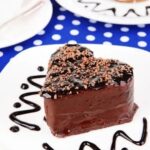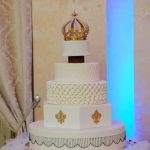Are you wondering how to put fondant decorations on a cake? Fondant decorations add a special touch to any cake, elevating its visual appeal and making it truly memorable. In this article, we will guide you through the process of creating and applying fondant decorations to a cake, ensuring that you achieve professional-looking results every time.
Fondant decorations are not only visually stunning but also versatile, allowing for endless creativity in cake design. Whether you want to create intricate flowers, elegant ribbons, or adorable figurines, fondant provides the perfect medium for bringing your cake vision to life.
In the following sections, we will walk you through the tools and materials needed for working with fondant, preparing the cake for decorations, creating various fondant designs, and troubleshooting common issues that may arise. By the end of this article, you will have the knowledge and confidence to adorn your cakes with beautiful and flawless fondant decorations.
Tools and Materials Needed
| Tool/Material | Importance |
|---|---|
| Fondant | The base material for creating decorations |
| Rolling Pin | Used for rolling out the fondant to the desired thickness |
| Cornstarch or powdered sugar | To prevent sticking when rolling out fondant and working with it |
Other essential tools include a smooth work surface, such as a silicone mat or marble slab, as well as non-stick board. It’s also important to have various sized cutters for creating specific shapes, as well as sculpting tools for fine detailing.
To ensure precise measurements and evenness, a ruler can be helpful during the preparation of fondant decorations. Lastly, having edible glue or clear vanilla extract and paintbrushes for attaching decorations and adding details is extremely important in putting together fondant decorations.
Always remember that using high-quality tools and ingredients can greatly affect the appearance and quality of your finished cake. Investing in these basic materials will help make the process smoother.
Now that you know what’s needed let’s move on to how to prepare your cake before applying any fondant.
Preparing the Cake
Before applying fondant decorations to a cake, it is crucial to properly prepare the cake to ensure a smooth and professional finish. The first step in preparing the cake is to level it. This involves trimming off any uneven or domed areas with a serrated knife to create a flat surface. This step is essential for achieving a neat and polished look once the fondant decorations are placed on the cake.
After leveling the cake, the next step is crumb coating. Crumb coating involves applying a thin layer of buttercream frosting all over the cake to seal in any loose crumbs. This initial layer acts as a base for the fondant and helps it adhere to the cake smoothly without any visible crumbs showing through.
Once the crumb coat has set, it’s time to apply a final layer of buttercream. This layer should be smooth and even, providing a perfect canvas for attaching fondant decorations. It’s crucial to take your time with this step, ensuring that there are no imperfections or air bubbles in the buttercream as these will be visible under the fondant.
Properly preparing the cake before adding fondant decorations sets the foundation for a beautiful end result. By paying attention to detail and taking your time during this process, you’ll ensure that your fondant decorations have an impeccable base to shine on.
Overall, taking care in each step of preparing the cake ensures that the final product not only looks visually stunning but also has a professional finish that will impress anyone who sees it. With patience and precision, you can achieve beautifully decorated cakes that showcase your creativity and skill in working with fondant decorations.
Working With Fondant
Rolling Out Fondant
Before you start working with fondant, make sure to knead it until it is smooth and pliable. Once the fondant is ready, dust your work surface with cornstarch or powdered sugar to prevent sticking. Use a rolling pin to roll out the fondant into a thin, even layer. Make sure to rotate the fondant frequently and lift it up from the work surface to prevent sticking.
Preventing Sticking and Tearing
To prevent sticking, continue dusting the work surface and rolling pin as needed. If you notice any tears or cracks in the fondant while rolling it out, gently smooth them over with your fingers. If a tear is too large to mend, consider re-rolling the fondant and starting again.
Handling Fondant Properly
When handling fondant, always use clean, dry hands to avoid leaving marks or smudges on the surface. To transport larger pieces of fondant onto your cake, roll it around your rolling pin and unroll it over the cake. This will help prevent tearing or wrinkling during transfer.
By following these simple tips and techniques for working with fondant, you’ll be able to create flawless decorations for your cakes without any tearing or wrinkling. With practice and patience, you’ll soon become an expert at putting fondant decorations on a cake.
Creating the Decorations
Creating fondant decorations for a cake is an exciting and creative process. Whether it’s delicate flowers, elegant ribbons, or adorable figurines, fondant decorations can elevate the appearance of any cake. Below are step-by-step instructions for creating various fondant decorations and expert tips for coloring and shaping them.
Flowers
To create fondant flowers, start by kneading the fondant until it is pliable. Then, roll out the fondant to your desired thickness using a rolling pin that has been dusted with cornstarch to prevent sticking. Use flower-shaped cutters or freehand cutting to shape the petals.
Next, gently thin out the edges of each petal with a ball tool or your fingers to create a natural curve. Layer the petals on top of each other, securing them together with edible glue or water at the center.
Ribbons
For fondant ribbons, roll out the fondant into a long strip using a rolling pin and cornstarch as needed. Use a sharp knife or pizza cutter to create clean edges. To add texture to the ribbon, consider using embossing tools or patterned rolling pins. Once you have achieved your desired look, gently drape the ribbon over a curved surface to dry in the shape you want to use on the cake.
Figurines
When creating fondant figurines, start by shaping basic body parts such as heads, torsos, arms, and legs separately before assembling them together. Use toothpicks or skewers to hold larger pieces together while they dry. For more intricate details like facial features or clothing folds, use small sculpting tools or even toothpicks.
With these techniques in mind, remember that food coloring can be used to customize the color of your fondant decorations. Consider wearing gloves during this process to avoid staining your hands. Pay attention to proportion and scale when shaping figurines so that they fit well on the cake without overwhelming its design.
Applying the Decorations
When it comes to putting fondant decorations on a cake, the process of applying the decorations is crucial for achieving a visually stunning result. Whether you are adding delicate flowers, intricate ribbons, or whimsical figurines, the way you attach and position the fondant decorations can make all the difference in the overall appearance of the cake.
In this section, we will explore the best techniques for attaching fondant decorations to your cake using edible glue or water, as well as how to position them for maximum visual impact.
Using Edible Glue or Water
One of the key considerations when applying fondant decorations to a cake is choosing the right adhesive. For smaller, lightweight decorations such as flowers or small embellishments, using water as an adhesive can be effective. Simply brush a small amount of water onto the back of the decoration and gently press it onto the surface of the cake.
For larger or heavier decorations, edible glue is often preferred as it provides a stronger hold. Apply a small amount of edible glue to the back of the decoration and then carefully place it onto the desired location on the cake.
Positioning for Visual Impact
In addition to choosing the right adhesive, positioning your fondant decorations strategically can elevate the overall look of your cake. Consider creating visual interest by placing decorations at varying heights and angles.
For example, if you are arranging a cluster of flowers on one side of the cake, try positioning some slightly higher than others to create dimension. Additionally, consider how different shapes and colors interact with each other and aim for a balanced composition across the entire surface of the cake.
Securing Larger Decorations
For larger fondant decorations such as figurines or multi-tiered designs, it may be necessary to use additional support to ensure they remain securely in place on top of your cake. One method is to insert food-safe support structures into your cake before applying your fondant layer. These supports can be as simple as wooden dowels or plastic straws that provide stability for larger and heavier elements.
By mastering these techniques for attaching and positioning fondant decorations on your cakes, you’ll be able to create show-stopping designs that are not only visually impressive but also structurally sound.
With these tips and techniques in mind, you’ll be well-equipped to take on any decorating challenge and create stunning cakes that are sure to impress.
Finishing Touches
Adding finishing touches to a cake can elevate its overall appearance and make it even more visually appealing. Here are some tips for adding those extra details to your fondant-decorated cake:
- Edible Glitter: Sprinkling edible glitter on your cake can add a touch of sparkle and glamour. You can use a brush to gently apply the glitter or sprinkle it using your fingers for a more scattered effect.
- Edible Paint: Using edible paint, you can add intricate designs, patterns, or even personalized messages to your fondant decorations. Simply dip a fine paintbrush into edible paint and carefully draw your desired design onto the fondant.
- Piping: Piping buttercream or royal icing onto the cake can create beautiful borders, swirls, or even delicate lace-like patterns. Practice piping on a separate surface before applying it to the cake for precision and control.
Remember that these finishing touches should complement your fondant decorations without overwhelming them. Use them sparingly and strategically for the best visual impact.
By incorporating these additional details, you can truly take your fondant-decorated cake to the next level, making it a show-stopping masterpiece that will impress any guest at your next special occasion. With patience and practice, you’ll soon be able to create stunning cakes that not only taste delicious but also look absolutely breathtaking.
Troubleshooting
Working with fondant decorations can be a fun and creative process, but it’s not without its challenges. There are several common issues that can arise when working with fondant, including cracks, air bubbles, and sagging. Thankfully, these problems can be easily troubleshooted with the right techniques and a bit of patience.
One of the most common issues when working with fondant decorations is the formation of cracks. Cracks can occur if the fondant is rolled too thin or if it’s not handled carefully. To troubleshoot this issue, you can try kneading the fondant to warm it up and make it more pliable. Additionally, gently smoothing the cracked areas with your fingers or a small amount of shortening can help to mend the cracks and create a smoother surface.
Another issue that often arises is air bubbles forming underneath the fondant. These unsightly bubbles can disrupt the smooth appearance of the decorations. To troubleshoot this problem, you can use a small pin to gently puncture the bubble and then smooth out the area with your fingers. It’s important to work carefully in order to avoid tearing or damaging the fondant while removing air bubbles.
Sagging is another common issue that many bakers encounter when working with fondant decorations on a cake. This can happen if the fondant is too heavy or if it’s placed on a cake that hasn’t been properly prepared.
To troubleshoot sagging fondant, you can try adding additional support underneath the decorations by inserting toothpicks or small dowels into the cake before placing the fondant on top. This will help to provide extra stability and prevent any sagging from occurring.
By being aware of these common issues and knowing how to troubleshoot them effectively, you’ll be better equipped to create flawless fondant decorations for your cakes. With patience and practice, you’ll soon become confident in your ability to troubleshoot any problems that may arise during the decoration process.
Conclusion
In conclusion, the art of putting fondant decorations on a cake requires precision and patience to achieve flawless results. The attention to detail and the careful handling of fondant are essential for creating stunning designs that will enhance any cake. By following the step-by-step guide provided, individuals can learn how to work with fondant and master the techniques needed to create beautiful decorations for their cakes.
It is important to remember that practice makes perfect when it comes to working with fondant. Experimenting with different designs, colors, and shapes will allow individuals to hone their skills and develop their own unique style. Whether it’s creating delicate flowers, intricate ribbons, or adorable figurines, the possibilities are endless when it comes to decorating a cake with fondant.
Lastly, as readers continue to refine their fondant decoration skills, they should not be discouraged by challenges or setbacks. Instead, they should view them as opportunities to learn and improve. With determination and perseverance, anyone can become proficient in the art of putting fondant decorations on a cake. So keep practicing, stay patient, and soon enough you’ll be creating professional-looking cakes adorned with stunning fondant decorations.
Frequently Asked Questions
How Do You Stick Fondant Decorations to a Cake?
Fondant decorations can be attached to a cake using a small amount of water, clear piping gel, or edible glue. Simply brush the back of the decoration with the chosen adhesive and press it onto the cake’s surface.
How Do You Put Fondant on a Cake for Beginners?
As a beginner, rolling out fondant to the desired thickness is key. Once rolled out, carefully lift the fondant using a rolling pin and drape it over the cake. Smooth out any air bubbles and trim off excess fondant for a clean finish.
Will Fondant Decorations Stick to Buttercream?
Fondant decorations can stick to buttercream if done correctly. It’s important to ensure that the buttercream has crusted slightly before attaching fondant decorations to prevent them from sinking or sliding off. Press gently to secure them in place.

Welcome to my blog about home and family. This blog is a place where I will share my thoughts, ideas, and experiences related to these important topics. I am a stay-at-home mom with two young children. I hope you enjoy reading it! and may find some helpful tips and ideas that will make your home and family life even better!





